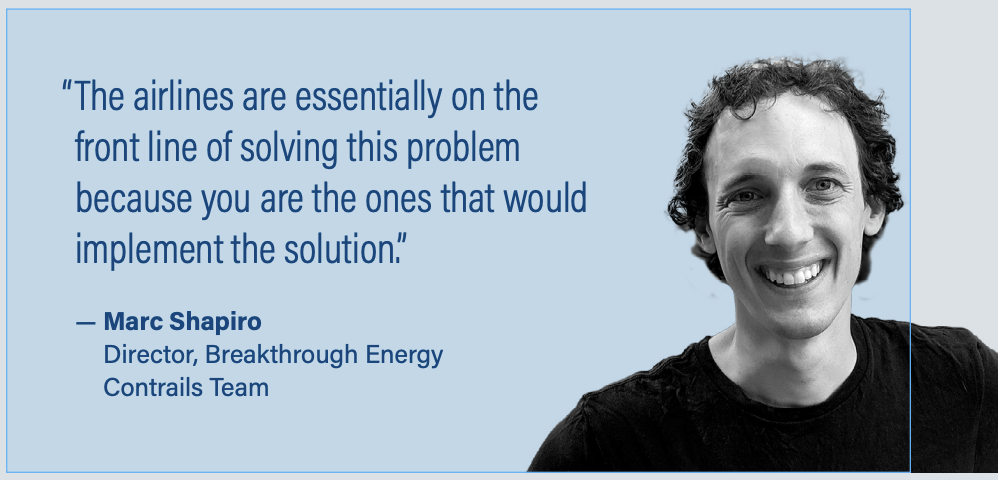In Conversation: Unveiling the Science Behind Contrail Avoidance
Marc Shapiro from Breakthrough Energy Discusses the Impact, Challenges, and American Airlines' Role in Mitigating Aviation's Climate Effects

Originally published in American Airlines' 2023 Sustainability Report
Marc Shapiro is the Director of the Breakthrough Energy Contrails team, one of American’s partners on contrail avoidance. Below, he answers our questions on the science behind contrail avoidance strategies, as well as some of the challenges in their implementation.
Prior to joining Breakthrough Energy, Marc worked as an applied scientist and entrepreneur in a diverse set of research and development efforts across fluid mechanics, geospatial analytics and mobile healthcare. In 2020, he started a company to develop geospatial data systems for climate mitigation and adaptation before transitioning to his current work. Marc earned a Master of Science degree in Fluids and Thermal Sciences from Brown University and a Bachelor of Engineering from Dartmouth College.
Marc, how would you compare the warming impact of contrails versus CO2 ?
It’s hard to compare them precisely, but CO2 is weakly warming over a long period of time, while contrails are strongly warming over a short period. But not all contrails have the same warming effect. Persistent contrails at night clearly impact the climate the most. By being more precise in our interventions and focusing on those, we have the greatest opportunity to make a difference.
How can we predict where warming contrails will occur?
There are fundamentally two ways to go about this. One involves using physics and meteorology to predict regions or volumes of air that should be avoided. The other uses observational techniques on the ground and from satellites to see where aircraft are actually forming contrails. In our work towards solving this problem, we need both.
What are the scientific challenges?
The type of atmospheric condition that creates persistent contrails is called ice supersaturation, which is a fancy way of saying the temperature is really cold and the humidity is high. Predicting that state is something that models have a hard time doing today. Another challenge is predicting these atmospheric states on as fine a scale as you need. Weather forecasts generally correspond to a grid, say, 25 kilometers by 25 kilometers. In that grid, you might have multiple fluctuations of supersaturation states. So, the model resolves to the average and it’s wrong sometimes.
Is there an easy way to describe your model?
Think of it like a weather forecast. We predict the probability that a contrail will form and an estimate of that contrail’s severity. The first part indicates how likely it is that an aircraft will form a persistent contrail in a particular area. The second part tells us that if we found a contrail in that area, it would likely have a particular persistence and impact on the climate.
Avoiding a contrail might also result in greater CO2 emissions. How should we look at the trade-off?
There is a cost in added fuel and CO2 that potentially gets added to the atmosphere as a result of avoidance maneuvers. Our models are telling us, though, only a few flights will be affected, and avoidance still results in a net climate benefit even over 100 years. We could reduce these added emissions if airlines had access to SAF. But from an operating standpoint, there’s a cost to the airline business in terms of greater fuel use, and no mechanism exists to share that cost right now.
How do you see American’s role in helping advance the solution?
The airlines are essentially on the front line of solving this problem because you are the ones that would implement the solution. So, what American is doing in helping us run trials is truly critical to advancing the research. The biggest hurdle to get through right now is not model development. It’s having the chance to really test and validate the model. Additionally, having a major airline working on this issue is a valuable signal that it’s important.

